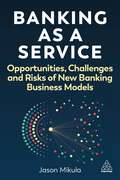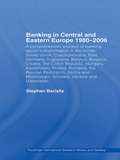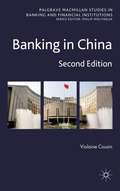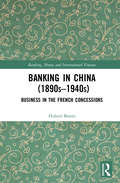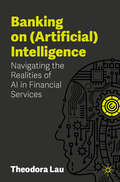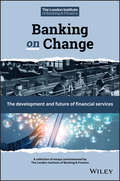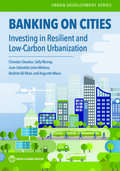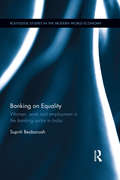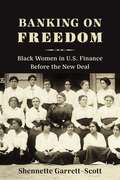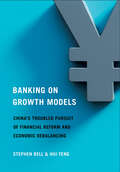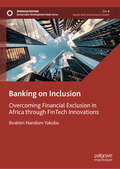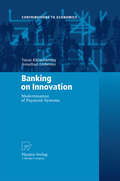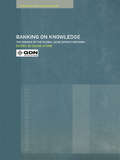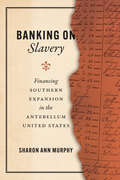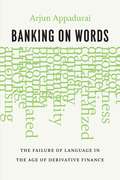- Table View
- List View
Banking and Monetary Policy from the Perspective of Austrian Economics
by Annette Godart-van der Kroon Patrik VonlanthenThis book discusses contemporary banking and monetary policy issues from the perspective of the Austrian School of Economics. Based on the heritage of the Austrian school, leading scholars and practitioners offer a coherent diagnosis and analysis of the factors leading to Europe’s current financial crisis. The first part of the book discusses Ludwig von Mises’s and Friedrich August von Hayek’s ideas on banking and monetary policy from both historical and economic standpoints. It includes contributions on Austrian monetary dynamics and micro-foundational business cycle theory, von Mises’s concepts of liquidity and solvency of fractional-reserve banks, and liberalism of Austrian economics. The second part analyzes the measures taken by the European Central Bank (ECB) in light of the ideas of von Mises and Hayek. It includes contributions on non-neutrality of money, ECB monetary policy, and the future of the ECB. The third and final part presents discussions on monetary reforms, including contributions on Bitcoins, Cryptocurrencies and anti-deflationist Paranoia.
Banking as a Service: Opportunities, Challenges, and Risks of New Banking Business Models
by Jason MikulaThis book provides a comprehensive look at banking-as-a-service (Baas), equipping readers with an understanding of the origins, evolution, future and applications of BaaS and the key differences across global markets.BaaS is a game changer in the financial services sector, radically transforming both how consumers experience financial products and the business models delivering them. Banking as a Service cuts through the hype to provide a measured overview of BaaS, helping readers to demystify a complex evolving field and understand its key opportunities, challenges and risks. It provides a framework for understanding where BaaS came from, how BaaS changes the economics and business models of banking products and services, its impact on key stakeholders, and its key regulatory implications. Banking as a Service explains how business and operating models work, exploring different models such as interchange, deposit gathering, loan origination-to-distribute, legacy, API-first, own licence, match-making and bank service providers and offers a framework for thinking about whether or not they're sustainable. It explores how BaaS operating and business models compare in different global territories and is supported by real-world examples and cases profiling organizations such as Blue Ridge Bank, Unit, Synapse, Goldman Sachs, Railsr, Starling, Solaris, Cacao Paycard, QNB, OnePipe, Airwallex, Nium and Pomelo. It also explains the differences between BaaS, embedded finance and open banking.
Banking for a Better World: Nanno Kleiterp in Conversation with Marijn Wiersma
by Nanno KleiterpWhen we look at all the challenges facing the world, including inequality, population migration, and climate change, we can see a role for development banking in nearly all of them. But will that role be played for good or ill? This book brings together two people who collectively draw on their forty-five years of experience in that world to argue that development banking can-and must-play a constructive role., We only need to read the news to find public outrage at tales of short-sighted greed in the financial world. But what happens when banks invest in long-term sustainability? Readers will find a fascinating example in the journey of the Dutch development bank FMO. At times global in perspective, at other moments intimately personal, Banking for a Better World interweaves candid anecdotes with development history, as well as banking lessons with client interviews, to deliver a powerful argument for a business model that generates profit through impact, and impact through profit., This is an important and accessible must-read for anyone involved in banking, business, policy making, and civil society as a whole. Banking for a Better World challenges us to start finding overlaps between our own lives and global issues and to bridge the distance between our personal needs and those of our planet.
Banking in Central and Eastern Europe 1980-2006: From Communism to Capitalism
by Stephan BarisitzComparative in structure and covering an extensive number of transition countries in its survey, this comprehensive book overviews the development of the banking systems in Central and Eastern European since the communist era until the present time.Taking in a range of countries including Hungary, Poland, Czech Republic, Slovakia, Bulgaria, Romania
Banking in China
by Violaine CousinChinese banks have been making headlines recently, but what lies beneath? Banking in China appears different. What explains the current arrangement? What can we expect from such a banking industry in the future? This book answers these two questions in a fully revised second edition and contributes to a new understanding of Chinese banks.
Banking in China: Business in the French Concessions (Banking, Money and International Finance #19)
by Hubert BoninFrom the 1890s to the 1940s, French State and entrepreneurial companies were enticed to promote French interests, beyond mere colonial targets, for the sake of economic patriotism. Chinese concessions, not including Hong Kong, were thus inserted into geo-economic moves, and French stakeholders asserted their philosophy of competition, and displayed their means of influence and investment. In this book, the author assesses the challenges which confronted French actors in the face of powerful British imperial action overseas, all the more so because German Belgian, Japanese, and then also North-American competitors joined the fray. The book targets three concessions: Canton/Guangzhou, Tientsin/Tianjin, and Hankeou/Wuhan because of their significance in the emergence of a modern economy in the country. The three main sections of the book explore the position of French stakeholders, mainly businessmen, merchant houses, bankers, and a few industrialists, in these three port-cities and China overall. The chapters gauge their capital of influence and networking, commercial tools, and banking skills in the face of competition, the hardships of crossing the changes in economic productive systems or clusters in the various port-cities and their areas, rich with commercial offshoots. Also, several chapters underscore the uncertainties caused by geopolitical and military events in China. For each of the three concessions, commercial and banking systems, assessments of the successes and limits of the French bankers and merchants are investigated, with the aim of evaluating the reality of French entrepreneurialism and power in the regions prospected by the offshoots of French capitalism. The book will be an invaluable resource for academics interested in the history of banking and finance, business, entrepreneurship, colonialism and "economic patriotism" in Chinese history, in geo-economics and in connected history.
Banking in Crisis
by John D. TurnerCan the lessons of the past help us to prevent another banking collapse in the future? This is the first book to tell the story of the rise and fall of British banking stability over the past two centuries, shedding new light on why banking systems crash and on the factors underpinning banking stability. John Turner shows that there have only been two major banking crises in Britain during this time - the crises of 1825–6 and 2007–8. Although there were episodic bouts of instability in the interim, the banking system was crisis free. Why was the British banking system stable for such a long time? And, why did the British banking system implode in 2008? In answering these questions, the book explores the long-run evolution of bank regulation, the role of the Bank of England, bank rescues and the need to hold shareholders to account.
Banking in Europe: The Quest for Profitability after the Great Financial Crisis (Palgrave Macmillan Studies in Banking and Financial Institutions)
by Mariarosa Borroni Simone RossiThis Palgrave Pivot provides a comprehensive overview of the dynamics that are affecting the profitability of European banks since the recent crisis period. More specifically, it sheds light on the most crucial changes in profit generation and on the consequential changes in banking strategies due to fiercer competition, reduced margin and changing regulation. The work is divided in four main parts. The first section introduces the changes in bank management policies, considering the periods before and since the crisis. In the second section, the authors review the literature on bank profitability and outline the main determinants of profit generation, and in the third section they provide a cross-country analysis of profitability for a wide sample of European banks during the great financial crisis. In the last section, the authors discuss the results of the quantitative analysis under the new regulatory and competitive framework that is progressively affecting the banking sector (fintech, Basel regulations, etc.). This book will be of interest to academics, researchers and students of European banking.
Banking in Europe: The Single Market (Routledge Library Editions: Banking & Finance)
by Robert DixonThis book describes the different banking systems of the twelve European Community countries and examines how they were affected by the Single European market of 1992. Exploring the implications of relevant EC legislation, the book highlights the problems that face financial institutions trying to expand their European operations and draws lessons from the efforts of major European banks to safeguard their own markets and independence in a more competitive European environment.
Banking in an Unregulated Environment: California, 1878-1905 (Routledge Library Editions: Banking & Finance)
by Lynne Pierson DotiThe study of financial history has never been more important. This volume focuses on theories about the relationship of financial markets to the rest of the economy. Searching out information on financial institutions and markets from the past, this work tests theories from the 1980s and 90s with this data, mainly in two fields of economics: financial structure and performance and economic development. Understanding and testing the relationship between money and credit and the level of output in the economy, the author emphasizes, may help predict or prevent business cycles and even make it possible to increase the rate of development and growth of an economy. Although this volume focuses on one geographical and historical area of the US economy, the lessons and implications are relevant for the global economy of the 21st century.
Banking on (Artificial) Intelligence: Navigating the Realities of AI in Financial Services
by Theodora LauThere is no lack of hype around artificial intelligence. We have only begun to scratch the surface of what this powerful technology can do. While tech and financial services become more intertwined, cutting through the noise has become more difficult but also more crucial. As a technology, AI is essential to advancing innovation, to creating efficiencies, and enhancing productivity while capturing opportunities by both incumbent financial institutions as well as fintechs. But it also comes with risks and potential for biases and disinformation, that can deepen inequalities and erode trust in our society. Responsible innovation must become part of our DNA and not as an afterthought. This book provides a tailored overview of what AI specifically means for financial services, a highly regulated yet also disrupted industry. It investigates the current state of AI applications in financial services today along with the state of funding and partnerships between tech and banking industries. It also examines the key pillars of responsible AI and the importance of keeping humans in the loop. The book takes a deep dive into the use cases in the financial services industry, the challenges and opportunities, and the fragmented regulatory landscape. How can we effectively assess risks, and balance innovation and customer centricity with trust in AI in financial services? Can smaller organizations reap the benefits of the technology? How can institutions deploy AI responsibly and securely, and promote a fairer and more equitable future for more people? While data is about bits and bytes, the realities of AI is very much human. This book will help spark dialogue and collaboration as we journey into the future.
Banking on Change: The Development and Future of Financial Services
by Ouida TaaffePRAISE FOR Banking on Change "In this 140th Anniversary celebration book, The London Institute of Banking and Finance stick to their core function of educating us all, but especially aspirant bankers, on the role and concerns of (retail and commercial) banking in the UK. They have assembled a well-chosen group of practitioners from a range of professions to write clear and easily assimilable essays, no technical expertise required, on a wide variety of current banking issues. If you want to learn about the current practices and problems of UK retail banking, this book must be essential reading." —Charles Goodhart, emeritus professor of banking and finance at the London School of Economics "In this important book, a line from Bill Allen's contribution is key: 'Nobody can predict the ferocity of the gale of creative destruction' that faces the financial services sector. True; but if you read the many and varied contributions, you'll have a pretty good idea. Moreover, you'll understand how we (that is, bankers) got here – and what we should do to make the industry more competitive, fairer and more genuinely useful. It is a soup-to-nuts look at banking – from the early days of the Institute of Banking, through the go-go years of ifs, to a present and future that are likely to be dominated by technology. It is well-worth a long read." —Andrew Hilton, director, Centre for the Study of Financial Innovation "If you were to imagine what a book celebrating 140 years of financial knowledge might contain, you could not come up with a better selection than this. As well as a historic sweep – from no-tech to fintech, the decline of trust and the rise of competition – today's hot subjects are addressed, including sustainable investing, cultural diversity and digital identity. The cradle-to-grave nature of the industry is captured in pieces about financial education and pensions. And it's well written, setting the scene nicely for the next era." —Jane Fuller, Fellow of the Society of Investment Professionals Financial services are undergoing rapid, and potentially dramatic, change. What will happen in payments, in sustainable finance and in fintech? How can the industry boost financial inclusion and ensure that its workforce has the skills it needs to meet regulatory requirements and to compete with new entrants? Can trade finance rise to the challenge of underpinning global trade for all and help the developing world avoid "financial abandonment"? What do financial services need to do to protect our digital identities? Banking on Change provides insights by experts and influencers from across the financial services industry on these and other questions. Published to mark the 140th anniversary of The London Institute of Banking & Finance, this book is intended to be of lasting value to both students and professionals.
Banking on Cities: Investing in Resilient and Low-Carbon Urbanization (Urban Development)
by Khan Chandan Deuskar Sally Murray Juan Sebastian Leiva MolanoCities around the world are responsible for ever-growing shares of people, assets, and economic activities vulnerable to climate disasters. They are also responsible for the majority of the world’s carbon emissions. Cities in low- and middle-income countries still have a window of opportunity to grow in resilient and low-carbon ways, to protect their populations and build strong and sustainable economic foundations. What are the resilient and low-carbon investments that these cities could make in the coming decades? How much will these investments cost, and where can cities look for resources to pay for these investments? These are the questions that 'Banking on Cities: Investing in Resilient and Low-Carbon Urbanization' considers. The publication provides the most comprehensive and up-to-date assessment of key resilient and low-carbon investment costs in major urban sectors in all low- and middle-income countries to 2050. These include investments in urban transportation, energy-efficient buildings, solid waste management, water and wastewater, flood protection, and heat resilience. The estimated total cost of these investments revealed by this analysis is sobering: between US$256 and US$821 billion per year. However, 'climate' investments are not a separate category of investments that cities need to make in addition to their regular investments. These are core urban investments that cities need to make for their local economic and social benefits in addition to their climate benefits. 'Banking on Cities' advances the discussion on urban climate finance by exploring how cities can identify sources of funding and finance that are suited to different types of resilient and low-carbon urban investments. Just as climate investments are not a separate category of investments, climate finance is not necessarily a separate category of finance. While climate-specific sources, including carbon markets, green bonds, and others, are part of the picture, making these investments will require cities to address their financial fundamentals, including revenues, transfers, creditworthiness, and fiscal efficiency. This report will be a helpful guide for cities and national governments as they develop their urban investment strategies.
Banking on Equality: Women, work and employment in the banking sector in India (Routledge Studies in the Modern World Economy)
by Supriti BezbaruahIt may well be surprising to say that the world should look to India as a model of gender equality. India’s banking sector proves the exception, with several women reaching the highest positions in India’s top banks, including the country’s largest bank. Based on interviews and surveys of bank employees in India’s National Capital Region, this book looks at what lies behind the media rhetoric and provides a systematic analysis of patterns of, and responses to, gender inequality in the banking sector in India. The book uncovers how gender discrimination still persists in the banking sector, albeit in covert forms. Through a comparison of nationalized, Indian private and foreign banks, the book demonstrates how the impact of laws, local cultural norms and gendered workplace practices are mediated through different organizational forms in these different types of banks to create varied experiences of gender inequality. The book is one of the first books to provide a thorough, in-depth analysis of women’s employment in the Indian banking sector, currently an under-researched area.
Banking on Fraud: Drexel, Junk Bonds, and Buyouts (Social Institutions And Social Change Ser.)
by Mary ZeyIn analyzing the fraud-facilitated leveraged buyouts engineered by Michael Milken and the firm of Drexel Burnham Lambert, the author suggests that such buyouts have multiple and extensive consequences for the organization of business and the economy. Zey also demonstrates how ordinary bond trading networks were linked to the extraordinary networks of the Boesky Organizations and Employee Private Partnerships in order to defraud bond issuers and buyers.This book debunks the myth of rational economic organization in the 1980s and establishes broad implications for theories of organizational deviance.
Banking on Freedom: Black Women in U.S. Finance Before the New Deal (Columbia Studies in the History of U.S. Capitalism)
by Shennette Garrett-ScottBetween 1888 and 1930, African Americans opened more than a hundred banks and thousands of other financial institutions. In Banking on Freedom, Shennette Garrett-Scott explores this rich period of black financial innovation and its transformative impact on U.S. capitalism through the story of the St. Luke Bank in Richmond, Virginia: the first and only bank run by black women.Banking on Freedom offers an unparalleled account of how black women carved out economic, social, and political power in contexts shaped by sexism, white supremacy, and capitalist exploitation. Garrett-Scott chronicles both the bank’s success and the challenges this success wrought, including extralegal violence and aggressive oversight from state actors who saw black economic autonomy as a threat to both democratic capitalism and the social order. The teller cage and boardroom became sites of activism and resistance as the leadership of president Maggie Lena Walker and other women board members kept the bank grounded in meeting the needs of working-class black women. The first book to center black women’s engagement with the elite sectors of banking, finance, and insurance, Banking on Freedom reveals the ways gender, race, and class shaped the meanings of wealth and risk in U.S. capitalism and society.
Banking on Growth Models: China's Troubled Pursuit of Financial Reform and Economic Rebalancing (Cornell Studies in Money)
by Stephen Bell Hui FengBanking on Growth Models contends that China's rapid economic rise from the late 1970s to today has been built on and shaped by a highly politicized and inefficient bank-centric financial system. Stephen Bell and Hui Feng argue that if the Chinese growth model drives how key economic sectors interact, no amount of incremental reform can have much impact on the financial system—meaningful reform can stem only from a revised growth model.For a time after the global financial crisis, it appeared that the expansion of a more market-oriented shadow banking system might help sustain China's economic growth. Since around 2015, however, Xi Jinping's regime has reversed this trajectory and placed China's financial system under heavy state control, resulting in slowed economic development and skyrocketing national debt. China's market transition and economic rebalancing are now in doubt, as is the fate of the nation's economy. By pinpointing finance as a vital element of the growth model, Bell and Feng provide a convincing assessment of financial risks and the prospects for economic rebalancing in China.Banking on Growth Models demystifies the world of Chinese banking and finance as it investigates an ever-rising national debt, a declining rate of economic growth, and the possibility of dire and drastic reform by the Asian superpower's government.
Banking on Inclusion: Overcoming Financial Exclusion in Africa through FinTech Innovations (Sustainable Development Goals Series)
by Ibrahim Nandom YakubuThis book offers a comprehensive analysis of how financial technology (FinTech) innovations are reshaping the financial landscape in Africa, addressing the critical issue of financial exclusion. It provides a focused examination of how digital solutions such as mobile money, digital banking, blockchain, and peer-to-peer lending are overcoming the longstanding barriers that have hindered access to formal financial services across the continent. These barriers include limited banking infrastructure, high transaction costs, and low financial literacy, all of which disproportionately affect underserved populations in both rural and urban areas. While financial exclusion is a global issue, Africa presents a unique case where the majority of the population remains unbanked or underbanked, despite the widespread use of mobile phones and the growth of digital ecosystems. By examining these specific regional challenges and offering targeted solutions, this book fills a gap in existing literature that often generalizes FinTech's impact without addressing the specific needs and circumstances of African economies. It will be of interest to academics, students, and policymakers of development finance, financial inclusion, financial services, and financial technology.
Banking on Innovation: Modernisation of Payment Systems (Contributions to Economics)
by Tanai Khiaonarong Jonathan LiebenaInnovation in banking should be directed at improving the infrastructure that fosters efficient financial services and international trade. In this work, innovation theory is used to show how modern payment systems have transformed the technology of banking and facilitated changes in the strategy and structure of financial services organisations. Design, implementation and dissemination of payment systems are described and the analysis of their costs and benefits is combined with case studies of banks undergoing change. By studying firm capabilities, competencies, and resources, the approach is extended to services in general and linked to the ability of firms to compete and promote national economies. Payment systems vary and advanced and developing economies face obstacles in their legal and technical infrastructure, and maturity of banks. By adopting an international perspective, the book offers a unique comparative analysis that shows what kind of investments are likely to be effective.
Banking on Knowledge: The Genesis of the Global Development Network (Routledge Studies in Globalisation)
by Diane StoneBanking on Knowledge is one of the first studies of how the World Bank is reinventing itself as the 'Knowledge Bank'. The book addresses how international organizations and governments are developing partnerships with think tanks, research institutes and other knowledge institutions in the hope of informing and improving policies for reform and development around the world.The book focuses on the recently established Global Development Network (GDN). The GDN is a new and ambitious initiative, sponsored by the World Bank, which is possibly the largest worldwide non-governmental enterprise aimed at producing knowledge as a public good on a global scale. Timely, original and provocative, this book is essential reading for students, researchers, policy makers and professionals with an interest in the future of the World Bank, the strategies of think tanks and the changing nature of development.
Banking on Reform
by William BernhardBanking on Reform examines the political determinants of recent reforms to monetary policy institutions in the industrial democracies. With these reforms, political parties have sought to draw on the political credibility of an independent central bank to cope with electoral consequences of economic internalization and deindustrialization. New Zealand and Italy made the initial efforts to grant their central banks independence. More recently, France, Spain, Britain, and Sweden have reformed their central banks' independence. Additionally, members of the European Union have implemented a single currency, with an independent European central bank to administer monetary policy. Banking on Reform stresses the politics surrounding the choice of these institutions, specifically the motivations of political parties. Where intraparty conflicts have threatened the party's ability to hold office, politicians have adopted an independent central bank. Where political parties have been secluded from the political consequences of economic change, reform has been thwarted or delayed. The drive toward a single currency also reflects these political concerns. By delegating monetary policy to the European level, politicians in the member states removed a potentially divisive issue from the domestic political agenda, allowing parties to rebuild their support constructed on the basis of other issues. William T. Bernhard provides a variety of evidence to support his argument, such as in-depth case accounts of recent central bank reforms in Italy and Britain, the role of the German Bundesbank in the policy process, and the adoption of the single currency in Europe. Additionally, he utilizes quantitative and statistical tests to enhance his argument.
Banking on Slavery: Financing Southern Expansion in the Antebellum United States (American Beginnings, 1500-1900 Ser.)
by Sharon Ann“A tremendous accomplishment . . . Banking on Slavery sets the stage for new understandings of the history of capitalism and its relation to slavery.” —Claire Priest, author of Credit NationIt’s now widely understood that the fullest expression of nineteenth-century American capitalism was found in the structures of chattel slavery. It’s also understood that almost every other institution and aspect of life then was at least entangled with—and often profited from—slavery’s perpetuation. Yet as Sharon Ann Murphy shows in her powerful and unprecedented book, the centrality of enslaved labor to banking in the antebellum United States is far greater than previously thought.Banking on Slavery sheds light on precisely how the financial relationships between banks and slaveholders worked across the nineteenth-century South. Murphy argues that the rapid spread of slavery in the South during the 1820s and ’30s depended significantly upon southern banks’ willingness to financialize enslaved lives, with the use of enslaved individuals as loan collateral proving central to these financial relationships. She makes clear how southern banks were ready—and, in some cases, even eager—to alter time-honored banking practices to meet the needs of slaveholders. In the end, many of these banks sacrificed themselves in their efforts to stabilize the slave economy. Murphy also details how banks and slaveholders transformed enslaved lives from physical bodies into abstract capital assets. Her book provides an essential examination of how our nation’s financial history is more intimately intertwined with the dehumanizing institution of slavery than scholars have previously thought.“The lives of enslaved persons caught in the web of the capitalist marketplace haunt the pages of Murphy’s excellent work.” ―Choice
Banking on Words: The Failure of Language in the Age of Derivative Finance
by Arjun AppaduraiIn this provocative look at one of the most important events of our time, renowned scholar Arjun Appadurai argues that the economic collapse of 2008—while indeed spurred on by greed, ignorance, weak regulation, and irresponsible risk-taking—was, ultimately, a failure of language. To prove this sophisticated point, he takes us into the world of derivative finance, which has become the core of contemporary trading and the primary target of blame for the collapse and all our subsequent woes. With incisive argumentation, he analyzes this challengingly technical world, drawing on thinkers such as J. L. Austin, Marcel Mauss, and Max Weber as theoretical guides to showcase the ways language—and particular failures in it—paved the way for ruin. Appadurai moves in four steps through his analysis. In the first, he highlights the importance of derivatives in contemporary finance, isolating them as the core technical innovation that markets have produced. In the second, he shows that derivatives are essentially written contracts about the future prices of assets—they are, crucially, a promise. Drawing on Mauss’s The Gift and Austin’s theories on linguistic performatives, Appadurai, in his third step, shows how the derivative exploits the linguistic power of the promise through the special form that money takes in finance as the most abstract form of commodity value. Finally, he pinpoints one crucial feature of derivatives (as seen in the housing market especially): that they can make promises that other promises will be broken. He then details how this feature spread contagiously through the market, snowballing into the systemic liquidity crisis that we are all too familiar with now. With his characteristic clarity, Appadurai explains one of the most complicated—and yet absolutely central—aspects of our modern economy. He makes the critical link we have long needed to make: between the numerical force of money and the linguistic force of what we say we will do with it.
Banking on the Future: The Fall and Rise of Central Banking
by David Green Howard DaviesAn inside look at the role and future of central banking in the global economyThe crash of 2008 revealed that the world's central banks had failed to offset the financial imbalances that led to the crisis, and lacked the tools to respond effectively. What lessons should central banks learn from the experience, and how, in a global financial system, should cooperation between them be enhanced? Banking on the Future provides a fascinating insider's look into how central banks have evolved and why they are critical to the functioning of market economies. The book asks whether, in light of the recent economic fallout, the central banking model needs radical reform.Supported by interviews with leading central bankers from around the world, and informed by the latest academic research, Banking on the Future considers such current issues as the place of asset prices and credit growth in anti-inflation policy, the appropriate role for central banks in banking supervision, the ways in which central banks provide liquidity to markets, the efficiency and cost-effectiveness of central banks, the culture and individuals working in these institutions, as well as the particular issues facing emerging markets and Islamic finance. Howard Davies and David Green set out detailed policy recommendations, including a reformulation of monetary policy, better metrics for financial stability, closer links with regulators, and a stronger emphasis on international cooperation.Exploring a crucial sector of the global economic system, Banking on the Future offers new ideas for restoring financial strength to the foundations of central banking.

